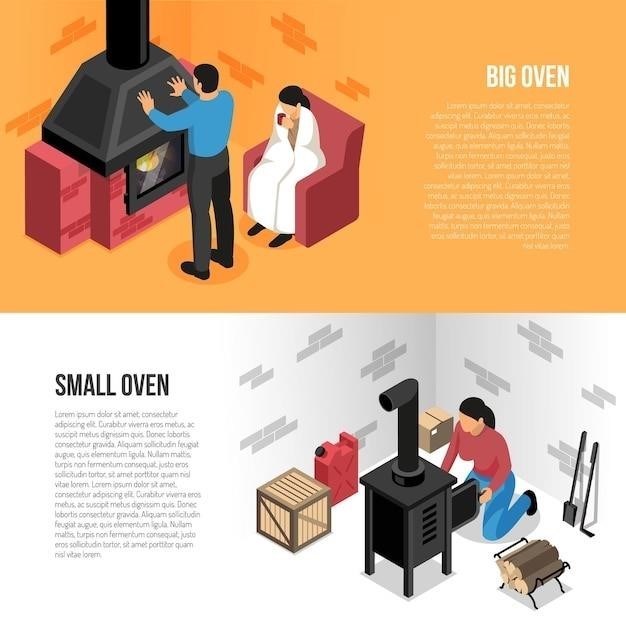Rocket Stove Design PDF⁚ A Comprehensive Guide

This comprehensive guide delves into the world of rocket stoves, providing a detailed overview of their design, construction, and benefits. From understanding different types of rocket stoves to mastering the principles behind their efficient combustion, this PDF will equip you with the knowledge to build your own sustainable and effective cooking solution.
Introduction
A rocket stove is a type of improved cooking stove that utilizes a unique design to achieve efficient combustion and reduced smoke emissions. This innovative stove design harnesses the power of a “rocket” effect, where hot air is rapidly drawn up a vertical chimney, creating a strong draft that intensifies the fire. The resulting high-temperature combustion leads to a significant reduction in fuel consumption, making rocket stoves an environmentally friendly and cost-effective cooking solution. This guide will explore the intricacies of rocket stove design, covering everything from the fundamental principles that govern their operation to the practical steps involved in building your own rocket stove. Whether you’re seeking a sustainable cooking option for your home, a compact and efficient stove for camping, or simply a fascinating DIY project, this comprehensive guide will provide you with the necessary knowledge to embark on your rocket stove journey.
Types of Rocket Stoves
Rocket stoves come in various designs, each catering to specific needs and applications. The most common types include⁚
- J-Rocket Stove⁚ This basic design features a J-shaped combustion chamber, where wood is fed into the top and burns in a vertical chamber before exiting through a horizontal flue. This design is simple to build and highly efficient.
- L-Rocket Stove⁚ Similar to the J-rocket, the L-rocket stove features a combustion chamber with a 90-degree bend. This design allows for more efficient heat transfer and can be used for cooking or heating.
- Rocket Mass Heater⁚ This type of rocket stove incorporates a large mass of material, such as clay or concrete, around the combustion chamber. This mass absorbs heat from the stove and slowly releases it over time, providing extended heating.
- Portable Rocket Stove⁚ Designed for outdoor use, portable rocket stoves are compact and lightweight, making them ideal for camping and hiking. These stoves typically utilize a metal construction and can be easily disassembled for transport.
The specific design of a rocket stove will depend on factors such as the intended application, available materials, and desired efficiency.
Rocket Stove Design Principles
The efficiency and effectiveness of a rocket stove stem from specific design principles that maximize combustion and heat transfer. These principles include⁚
- Restricted Airflow⁚ Rocket stoves utilize a restricted airflow system, allowing for a controlled burn with minimal smoke and ash. This is achieved by creating a narrow burn tunnel, which forces hot air to rise rapidly through a vertical flue.
- Secondary Combustion⁚ The hot air rising through the flue creates a draft, drawing in fresh air from the base of the stove. This fresh air mixes with the hot gases in the flue, promoting secondary combustion and maximizing heat generation.
- Heat Riser⁚ The vertical flue, often referred to as a heat riser, is designed to accelerate the upward flow of hot gases. The design of the heat riser, including its height and diameter, significantly influences the efficiency of the stove.
- Burn Tunnel⁚ The burn tunnel is the primary combustion chamber where wood is fed and burned. Its dimensions and shape influence the airflow and efficiency of the stove.
By understanding and applying these principles, you can design a rocket stove that burns efficiently and effectively, minimizing fuel consumption and maximizing heat output.
Essential Components of a Rocket Stove
A rocket stove, despite its seemingly simple design, comprises several essential components that work together to achieve efficient combustion and heat transfer. These components include⁚
- Feed Tube⁚ The feed tube is the opening through which fuel is added to the stove. It typically has a larger diameter than the burn tunnel, allowing for easy fuel loading.
- Burn Tunnel⁚ The burn tunnel is the primary combustion chamber, where wood is burned. It is a narrow, vertical chamber that allows for a controlled burn with minimal smoke and ash.
- Heat Riser⁚ The heat riser is a vertical flue that connects the burn tunnel to the cooking chamber. It accelerates the upward flow of hot gases, maximizing heat transfer to the cooking surface.
- Cooking Chamber⁚ The cooking chamber sits above the heat riser and is where food is prepared. It can be a simple platform or a more elaborate design depending on the stove’s intended use.
- Ash Pan⁚ An optional but beneficial component, the ash pan collects ash from the burn tunnel, making it easier to clean and maintain the stove.
These components are carefully designed and interconnected to create a system that promotes efficient combustion and heat generation, making rocket stoves a practical and sustainable cooking solution.

Construction Materials for Rocket Stoves
The choice of materials for building a rocket stove is crucial, as they need to withstand high temperatures, resist wear and tear, and be readily available. Here are some common materials used in rocket stove construction⁚
- Firebrick⁚ Firebrick is the preferred material for the burn tunnel and heat riser due to its exceptional heat resistance. It can withstand high temperatures without cracking or breaking, ensuring a long-lasting and safe stove.
- Metal⁚ Metal, particularly steel, is commonly used for the feed tube, cooking chamber, and ash pan. It is durable and readily available, making it a practical choice for these components. Stainless steel is preferred for its corrosion resistance.
- Clay Bricks⁚ Clay bricks can be used to build the outer structure of the stove, providing insulation and stability. They are a readily available and cost-effective option, especially in regions where clay is abundant.
- Concrete⁚ Concrete can be used to create a stable base for the rocket stove, ensuring its structural integrity. It is a durable and long-lasting material, suitable for outdoor installations;
- Earth⁚ Earth, particularly cob or rammed earth, can be used for building the outer structure of the stove, providing natural insulation and a rustic aesthetic. This is a sustainable and eco-friendly option, often used in off-grid settings.
The choice of materials ultimately depends on factors such as availability, budget, and desired aesthetic, but the key is to select materials that can withstand the intense heat generated during combustion.
Building a Rocket Stove⁚ Step-by-Step Guide
Constructing a rocket stove is a rewarding project that combines creativity and practicality. This step-by-step guide provides a framework for building your own efficient and sustainable cooking solution⁚
- Gather Materials⁚ Begin by gathering all the necessary materials, including firebrick, metal, clay bricks, concrete, or earth, depending on your chosen design. Ensure you have the right tools, such as a saw, hammer, trowel, and measuring tape.
- Prepare the Foundation⁚ Create a stable base for your rocket stove, using concrete, bricks, or a sturdy platform. Ensure it is level and can withstand the weight of the stove.
- Build the Combustion Chamber⁚ Construct the burn tunnel and heat riser using firebrick. The dimensions should follow your chosen design plan. Ensure a tight fit between the bricks, using mortar or clay to seal any gaps.
- Assemble the Feed Tube⁚ Attach the metal feed tube to the top of the burn tunnel, creating a vertical opening for adding fuel. Securely connect the feed tube to the combustion chamber.
- Construct the Cooking Chamber⁚ Build the cooking chamber, which sits atop the heat riser. This can be made from metal, clay bricks, or another suitable material. The cooking chamber should be large enough to accommodate your cooking pots.
- Create the Ash Pan⁚ Attach a metal ash pan to the base of the burn tunnel to collect ash and debris. Ensure it is easily removable for cleaning.
- Build the Outer Structure⁚ Construct the outer structure of the stove using clay bricks, concrete, or earth. This provides insulation and a finished aesthetic;
- Test and Refine⁚ Once the stove is assembled, test it by starting a small fire. Observe the airflow and adjust the dimensions or construction as needed to optimize efficiency and reduce smoke.
Remember to follow safety precautions throughout the construction process and refer to your chosen design plan for specific instructions.
Safety Considerations
While rocket stoves offer numerous benefits, it’s crucial to prioritize safety during construction and operation. Here are some key considerations to ensure a safe and enjoyable experience⁚
- Fire Safety⁚ Always operate the rocket stove in a well-ventilated area, far from flammable materials. Keep a fire extinguisher readily available and ensure a source of water is nearby for emergencies.
- Heat and Burns⁚ The rocket stove generates significant heat, particularly around the combustion chamber and heat riser. Avoid touching these areas while the stove is in operation and use caution when handling hot cooking pots.
- Carbon Monoxide⁚ Ensure proper ventilation to prevent carbon monoxide buildup. Avoid using the stove in enclosed spaces without adequate airflow.
- Smoke and Ash⁚ Rocket stoves can produce some smoke, especially during the initial stages of a fire. Use caution when handling ashes, as they can be hot and can cause irritation.
- Children and Pets⁚ Keep children and pets away from the operating stove to prevent accidents. Ensure the stove is placed in a secure location where it cannot be easily accessed by young children or curious pets.
- Construction Safety⁚ Wear appropriate safety gear, including gloves, eye protection, and dust masks, during the construction process to protect yourself from potential hazards associated with working with tools and materials;
By following these safety considerations, you can enjoy the benefits of a rocket stove without compromising your well-being. Always exercise caution and prioritize safety when working with fire and heat.
Advantages of Rocket Stoves
Rocket stoves have gained popularity for their numerous advantages, making them an attractive alternative to traditional cooking stoves. These benefits encompass efficiency, sustainability, and overall performance⁚
- Fuel Efficiency⁚ Rocket stoves are highly efficient in burning fuel, requiring less wood compared to conventional stoves. This translates to significant savings on firewood, making them an eco-friendly option.
- Reduced Smoke Emissions⁚ The unique design of rocket stoves promotes complete combustion, resulting in significantly lower smoke emissions. This is beneficial for both indoor and outdoor environments, improving air quality and reducing respiratory health risks.
- Fast Heating and Cooking⁚ The intense heat generated by rocket stoves allows for rapid heating and cooking times. This efficiency makes them ideal for both everyday cooking and emergency situations.
- Versatility⁚ Rocket stoves can be adapted for various cooking needs, from boiling water and simmering stews to baking and roasting. Their versatile design caters to diverse culinary preferences.
- Easy Construction⁚ Rocket stoves can be constructed using readily available materials, making them a DIY-friendly project. Numerous online resources and plans provide detailed instructions for building your own stove.
- Sustainability⁚ By reducing fuel consumption and promoting efficient combustion, rocket stoves contribute to environmental sustainability. They minimize the impact on forest resources and reduce greenhouse gas emissions.
These advantages make rocket stoves a compelling solution for individuals seeking a more efficient, sustainable, and cost-effective cooking method. They offer a practical and environmentally conscious approach to meeting cooking needs, particularly in areas where fuel resources are limited.
Rocket Stove Design PDF Resources
The internet provides a wealth of resources for individuals interested in learning more about rocket stove design and construction. These resources offer detailed plans, diagrams, and instructions to guide you through the process of building your own efficient and sustainable cooking solution. Here are some valuable online resources⁚
- Defiant Metal⁚ This resource offers a free PDF download containing rocket stove plans. These plans provide detailed specifications and instructions for constructing a rocket stove, ensuring a successful build.
- Sustainable Shelter and Wood Stove Plans⁚ This resource provides a comprehensive PDF document that includes technical drawings and specifications for building a sustainable shelter, along with a wood stove. The document contains detailed instructions for building a rocket stove foundation, optimizing efficiency, and ensuring safety.
- Construction Manual for the Firewood Saving Rocket Stove⁚ This free PDF manual provides detailed instructions for constructing a rocket stove designed for efficient firewood usage. The manual covers various aspects of construction, including materials, dimensions, and assembly procedures.
- Rocket Stove Design Websites⁚ Websites dedicated to rocket stove design and construction offer a vast array of information, including articles, tutorials, and plans. These online resources provide a comprehensive understanding of rocket stove principles, construction techniques, and practical tips for optimizing performance.
By utilizing these online resources, individuals can access valuable information and guidance to design and build their own rocket stoves, embracing a sustainable and efficient approach to cooking.
